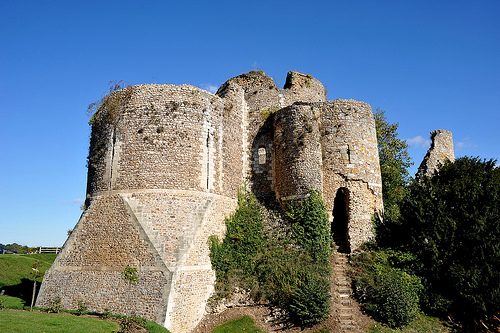

Location: Eure department, Haute-Normandie region Map
Constructed: 1035 by Roger I of Tosny
Château de Conches-en-Ouche is located in Conches-en-Ouche commune of Eure department of France. The original military fortifications were at least three stories high constructed on a motte or a tall mound. Its walls were 2.60 meters in thickness. Castle of Conches-en-Ouche was constructed in 1035 by Roger I of Tosny. It was captured by Philip II of the France in 1199. During the Hundred Years' War between France and England the stronghold saw a lot of military action. It was taken by the invading French troops in 1364, but in 1371 it was recaptured by the French. In 1420 it was taken again by the English, retaken in 1440 by the French, taken by the English in 1441 and retaken by the French crown finally in 1449. The castle was destroyed in the 16th century during the French Wars of Religions between the Protestants and Catholics. The stronghold was held by the Catholic League who opposed Henry of Navarre, king of France. The king destroyed the fortress to make sure his enemies would not be able to use this fort.
The ruins of the keep are located in the village, overlooking the Rouloir valley and the town, 150 meters south-east of the Sainte-Foy church in Conches-en-Ouche, in the French department of Eure.
The start of construction dates back to around 1034 with Roger I of
Tosny. The lords of Tosny, whose origin remains obscure, inherited this
stronghold then called Castellio in medieval Latin (Castillon in
northern Norman and Occitan, Chastillon in southern Norman and in old
French, hence Châtillon).
The castle was taken by Philippe
Auguste in 1199 who gave it in 1202 to his cousin Robert de Courtenay.
The castle is enlarged, flanking towers are added to the outer
enclosure.
Conches-en-Ouche was a stronghold of Robert d'Artois,
the man who participated with the English in the Hundred Years' War,
which Maurice Druon, in his historical saga Les Rois maudits, made the
trigger for the conflict. The city suffered the ride of Henry of
Lancaster in 1356, and the castle was burned down.
In 1354 at the
Treaty of Mantes, the city and its fortress were given by the King of
France Jean II to King Charles II of Navarre, known as the Bad, with the
county of Beaumont-le-Roger, the viscounty of Pont-Audemer and the Clos
du Cotentin. Le Mauvais entrusts the city to Captal de Buch Jean de
Grailly, who in turn entrusts it to his uncle Archambaud. Claiming that
the captal had passed to the English, Bertrand du Guesclin laid siege to
Conches in 1371 and took over the fortress. An agreement was signed on
February 4, 1371 and the Navarrese evacuated the city. This surrender
seven years before the conquest of the property of the King of Navarre
by Charles V meant that Conches was not destroyed like the other
fortresses of Charles II of Navarre.
Henry V of England seized
the castle in 1420. Conches was taken over by the French in 1440 and the
following year by the English. They will be driven out by Robert de
Floques, bailiff of Évreux.
In 1591, the castle served as a
refuge for members of the League. Remaining a potential point of support
for the enemies of the monarchy, it was dismantled in the 16th century.
The 11th century keep is built on a motte, in the center of an old
barnyard located at its feet, which included a parish enclosure housing
a church and probably a habitat. Of the farmyard, transformed into a
public garden, only the entrance remains, enclosed in half-timbered
houses.
The building had walls 2.60 meters wide, and at least
three floors. The cylindrical keep, enclosed in its jacket flanked at
each of its corners by semi-circular towers very close together and
almost contiguous, was built by Roger VI of Tosny, around 1175,
prefiguring the arrangements of Château-Gaillard.